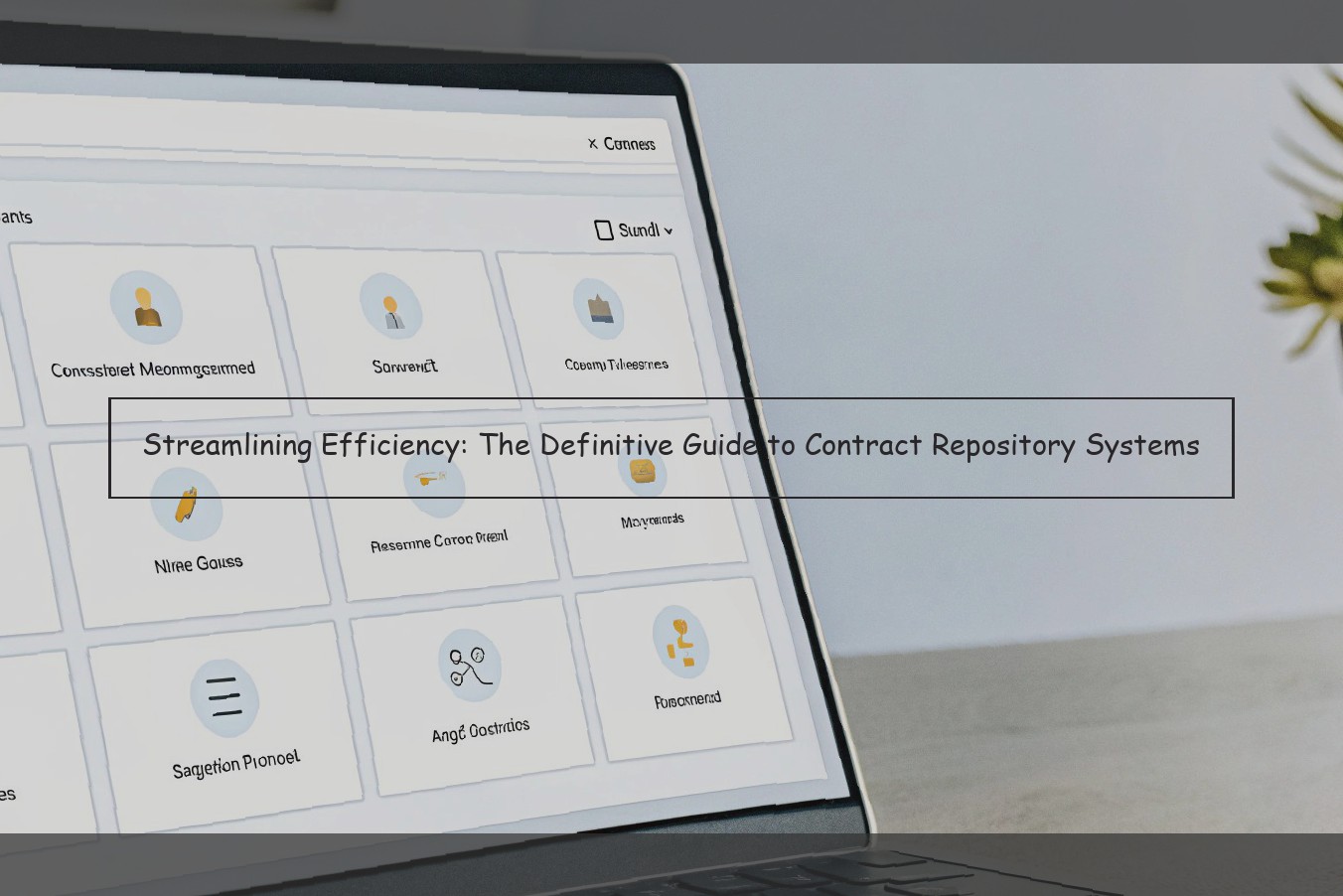What is a Contract Repository System?
The definition of a contract repository system is simply a repository or database of contracts. This system’s main purpose is to store and organize your legal documents. Typically a contract repository systems allows you to search through contracts using text based searches and can even provide easy access to portions of a contract.
What’s the usefulness of a contract repository? Without a contract repository system , your contracts or contracts could be anywhere in your document filing system. It would take hours to find them all. A contract repository system allows you to access your contracts with ease. They’re powerful because it allows for a central location for your contracts and your metadata. Metadata is important to track information relating to a contract. Some examples of metadata are renewal dates, termination dates, expiration dates, and other provisions relating to the contract. When a contract is housed in a contract repository, you can even search by the metadata. By managing your contracts in a contract repository system, you are being efficient, organized and prepared.

The Top Benefits of a Contract Repository System
The key benefits of using a contract repository system are the following:
- Better organization of contracts and related information like insurance documents, amendments, SOW’s, NDAs, Manuals, etc.
- Reduced risk of failure to comply with contractual obligations due to better awareness and monitoring of what’s coming due, when and every occurrence in the life cycle of the agreement.
- Version control. This is especially important to avoid reliance on an improper iteration of the agreement.
- A single point of reference for all of the terms and conditions of a written agreement.
- Easy access and searching, in some cases, of contracts by various and different categories of information (e.g., contract type, vendor, contract administrator, terms, renewal dates, insurance types, parties, etc.) or for particular clauses or languages that may be relevant for any particular purpose, including compliance with franchise or other license laws.
- Better flow of contract information between departments or offices, or in the case of a franchise disclosure document, between franchisors and franchisees, and may be considered a part of the franchisor’s FDD in the franchise registration process.
- Ability to track compliance with contractual obligations by your counterparts and better awareness of obligations under the agreement and the diligence that may be required to meet those obligations.
- Online or cloud-based software allows greater flexibility to authorize different personnel for different functions, such as administration, and for different offices to upload documents and for all users to access it accurately and timely.
- Analytics and other support. Various software tools may serve as road maps in the administration of all of your agreements, including during a crisis.
Essential Contract Repository System Features
With so many options available, the choice of a contract repository solution can be overwhelming. After narrowing your requirements down to top contenders it is important to understand the features which will help maximize the value of your system. Contract search is supremely important when it comes to keeping business processes running and your entire organisation informed. With the right tool, users can search within a document’s content and metadata, their results are then displayed in a consistent format with an intuitive and informative preview area. Contracts are often requested from many areas of business including sales, marketing and procurement, and should be available on-demand without specialist intervention. A contract repository solution should provide the ability to generate a range of different documents from individual pieces of data. The best document assembly functionality will be fully integrated with the rest of the system, and will support complex business rules. Such a fully automated solution will include options such as alerts when the deadline for renewal is approaching, and an indication of who is responsible for taking action. A good contract repository should include a role and permission management system which supports both administrative and end-user roles. This will allow you to establish a controlled environment in which users can only view documents that they have permission to see. Security is paramount, and the repository should include features such as user-level password protection for sensitive documents, and an internal audit system. One of the most important security features will be the ability to restrict explorable areas in the document, like authorisation terms, price or volume. When searching a repository, it should be possible to quickly understand what search terms were used to locate specific documents. A leading contract management solution will allow users to search using multiple criteria, ranging from parties involved in the contract and the amount of the deal to contract type (services, non-disclosure agreement etc.) and term. A contract repository should be the primary source for reporting, therefore it is vital that you choose a contract repository solution that offers reporting capability robust enough to support day-to-day decision making as well as high-level audit purposes. A good reporting capability will include the ability to filter by contract dimensions (party, type, termination provisions, business unit, etc.), and to export reports quickly and easily.
The Steps to a Successful Contract Repository System Implementation
The implementation phase of a new contract repository system involves several steps to ensure a successful transition from an old database or filing system to the new software program. First, an organization must identify its systems and information that will be used as the foundation for a new contract repository system. These can include: Second, the organization must choose the software program that will function as the contract repository system. There are many options in various price ranges, with a variety of features and capabilities. Taking time upfront to determine the organization’s desired functionality will help ensure that the comprehensive solution is selected in the beginning. This will also mitigate the need to again migrate the data at a later time. Customization may be necessary for some software systems, and this process will require additional time and coordination from the stakeholders. With the software program selected, the next step is data migration. This process is often tedious and complex. There may be old records in a variety of locations (physical and electronic) as well as various sources for information that are not contained in any record, but still require input into the new contract repository system. Some data may be incomplete, or in a form that is inconsistent with the new contract repository system. The organization’s stakeholders need to participate in the data migration process by answering questions and providing missing data when possible. Once the data has been migrated to the new system, the issues with the original information must also be addressed, such as: The last step for implementing a new contract repository system is training. Initially, stakeholders and other personnel who will be responsible for maintaining the contract database should be trained on the new system. Depending on the nature of the data in the old filed system and the materials used for training, the training may be for the purpose of adding historical information into the new contract repository system, or for migrating active information and continuing operations. If the stakeholders and other personnel will be responsible for training others within the organization, they need to be familiar enough with the system to be able to effectively train others. Once the contract repository system has been implemented, the organization should review the written procedures regularly to confirm that the contract database system remains consistent with its needs. Updating procedures should be done with careful consideration of the users’ perspectives to avoid additions or changes that add only complexity to the processes.
Common Pain Points in Contract Management
Efficiently handling contracts requires a cohesive contract management system. Businesses often struggle with centralized contract storage, contract circulation, modifications management and sharing contracts with relevant stakeholders. If you are using different methods to manage your contract information, such as spreadsheets, emails, silos and pdf files, it is highly likely you are unable to effectively manage contracts.
Centralized contract filing is one of the biggest challenges buyers face when it comes to managing contracts. Lack of central repository creates multiple points of contact issue during contract drafting and circulation stage. Further, with every change in contract clause, there is a whole new version of the contract making it difficult for the contract manager to identify which version of the contract reflects negotiated terms. In the absence of central repository solution, contract managers literally have to pull their hair out searching the contract they need. Adoption of contract management software overcomes common issues associated with manual handling of contracts. Contract repository software centralizes all your contracts in one place while providing you the flexibility to filter them based on various attributes and quickly find the one you are looking for.
Lack of standardization and transparency across businesses can be arduous task which is difficult to navigate. When it comes to managing contracts , lack of standardization can lead to poor performance and inconsistent practices. Businesses often overlook the significance of tracking the contracts on regular basis and this increases the chances of missing contract renewal dates. Also, there is lack of transparency between operational teams, sales and legal team which often leads to foot dragging and even worse to missed milestones. In order to avoid procrastination and help you have a clear oversight of contracts, use a contract lifecycle management solution. A contract repository creates accountability by centralizing all your contracts in one place. It helps you make informed decisions by providing you a real time overview of contracts. To handle your contracts efficiently, you can even assign individual right access to each department and each user. So your legal team can only have access to legal contracts and finance department can only view financial contracts. This helps you to increase your visibility into which contracts are expiring and which ones are up for renewal.
How to Select the Ideal Contract Repository System for Your Organisation
When contemplating a contract repository system, the earliest consideration should be the company’s specific needs. In some instances, a simple solution may suffice. For example, a one or two person practice may simply be satisfied with the ability to upload scanned documents and basic contract information on an as-needed basis. These practitioners generally will be content with the basic features that most publicly available contract repository systems provide.
A larger organization, on the other hand, will need to consider many more factors when considering a contract repository solution. Issues such as the general size of the company and its projected contract volume, industry specific issues, current and future workforce growth generally and whether outside counsel will have access to the repository all are considerations. In addition, factors such as overall data security and the specific security needs of employees in certain verticals must be considered. Companies that operate in verticals with high security needs may be better served by an enterprise-level solution.
A further consideration is whether the company will be using commercial software that must be integrated into the repository. Many companies will choose to integrate outlook and word programs into the system to manage tracking and reminders. Companies that face complex and/or specialized workflows will require a repository that provides a highly customizable workflow. This needs assessment should help to narrow the field in terms of being able to select the repository that can conform to the specific business needs of the company.
Emerging Trends in Contract Repository Systems
Recent developments in contract repository systems have been focused on automation, with Wilson Allen and Extranet Solutions as just two examples of companies working in that area. There are a number of providers who are more mature in the automation area: iManage, Workshare and NetDocuments, and we expect further automation features will be introduced in future versions of contract repository systems from those and other providers.
While some may argue that contract repository systems simply automate a tedious process, we see the future of contract repository systems with tight integrations with digital signature systems such as DocuSign, Adobe Sign, and HelloSign. In turn, contract repository systems should also be integrated with signature verification tools. Of course, these integrations will be driven by strong application programming interfaces (APIs) between systems.
Natural language contracts, written by drafting contracts with specific clauses that are natural language processing friendly, will become a requirement for easy integration with contract repository systems. In the future, machine learning tools could be leveraged to help create natural language contracts .
Contract repository systems will not just store contracts, but with integrated analytics technology, contract repository systems will alert users to renewal dates, audit compliance with important terms, and provide value-added reporting capabilities. And we expect to see some form of AI or automation in review, approval, negotiation, and access processes.
The next evolution of contract repository systems will include processes that guide the user substantially through the contract lifecycle into automated workflows, interactive guided negotiations, and high-integrity contracts.
We will also start to see document management capabilities, including document management requirements on contract repository systems in the future, expand to more than just a basic version control process. We see a more sophisticated and integrated document review and approval process that will help ensure the best version of contracts is stored in the repository. It will also facilitate the ability to conduct exhibitions, redlining, and real-time collaboration on contract changes on contracts into the future.
As the complexities of contracts increase, we expect these "intelligent" contract repository systems to continue to evolve rapidly.



